No, I don't mean that the current carnival begets lousy memories. I just can't seem to remember until the last minute to promote the upcoming edition (and ready my own submissions). Entries for the next carnival are due Friday p.m., according to the info at the Carnival Mother Ship. Please make first-time host Michael O'Conner feel welcome by dumping a ton of submissions on him.
The Confession of Saint Peter ("You are the Christ, the Son of the Living God") is commemorated on 18 January, and the Conversion of Saint Paul on his approach to Damascus a week later, on 25 January. On 29 June we commemorate the martyrdoms of both apostles. The date is the anniversary of a day around AD 258, under the Valerian persecution, when what were believed to be the remains of the two apostles were both moved temporarily to prevent them from falling into the hands of the persecutors.
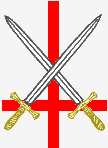 The Scriptures do not record the deaths of Peter or Paul, or indeed any of the Apostles' deaths except for James the son of Zebedee (Acts 12:2), but they are clearly anticipated (see the readings below), and from an early date it has been said that they were martyred at Rome at the command of the Emperor Nero, and buried there. As a Roman citizen, St. Paul would probably have been beheaded with a sword. An early tradition claims that St. Peter was crucified head downward.
The Scriptures do not record the deaths of Peter or Paul, or indeed any of the Apostles' deaths except for James the son of Zebedee (Acts 12:2), but they are clearly anticipated (see the readings below), and from an early date it has been said that they were martyred at Rome at the command of the Emperor Nero, and buried there. As a Roman citizen, St. Paul would probably have been beheaded with a sword. An early tradition claims that St. Peter was crucified head downward.The present Church of St. Peter in Rome replaces earlier churches built on the same site going back to the time of the Emperor Constantine, in whose reign a church was built on what was believed to be the burial site of Peter. Excavations under the church suggest that the belief that this is the true home of his burial predates Constantine.
Lection from the 1- and 3-Year Series
Psalm 46 or 18:25-32
Ezekiel 34:11-16 (both series)
Acts 12:1-11 or 1 Corinthians 3:16-23
Matthew 15:13-20 or Mark 8:27-35
Collect
Merciful and eternal God, from whom the holy apostles Saint Peter and Saint Paul received grace and strength to lay down their lives for the sake of Your Son, grant that, strengthened by the Holy Spirit, we may with like constancy confess Your truth and be at all times ready to lay down our lives for Him who laid down His life for us; even Jesus Christ, our Lord, who lives and reigns with You and the Holy Spirit, one God, now and forever.
Technorati Tags: Saint Peter | Saint Paul | Saints Peter and Paul | apostles | martyr | martyrdom | Paul | Peter | Emperor Nero | Nero | beheading | crucifixion | Valerian | Valerian Persecution
The Evangelical ghostwriter himself, the featured flamethrower of Luther at the Movies, after a brief time away, now tells the masses (and the Matins, the Vespers, &c.), I'm Back.
 Irenaeus (ca. AD 130-200), believed to be a native of Smyrna (modern Izmir, Turkey), studied in Rome and later became pastor in Lyons, France. Around 177, while Irenaeus was away from Lyons, a fierce persecution of Christians led to the martyrdom of his bishop. Upon Irenaeus' return, he became Bishop of Lyons.
Irenaeus (ca. AD 130-200), believed to be a native of Smyrna (modern Izmir, Turkey), studied in Rome and later became pastor in Lyons, France. Around 177, while Irenaeus was away from Lyons, a fierce persecution of Christians led to the martyrdom of his bishop. Upon Irenaeus' return, he became Bishop of Lyons.Among his most famous writings is Adversus Haereses (Against Heresies). This work condemned several errors but focused especially on Gnosticism, which denied the goodness of creation. In opposition, Irenaeus confessed that God has redeemed his creation through the incarnation of the Son. Irenaeus also affirmed the teachings of the Scriptures handed down to and through him as being normative for the Church.
Despite a few stray texts, very little suggests that he did not die a natural death. He was buried in Saint John's Church, Lyon — a congregation later renamed in his honor. Iconoclastic Huegenot Calvinists destroyed his tomb and remains in 1522.
Collect
Almighty God, You upheld your servant Irenaeus, giving him strength to confess the truth against every false doctrine; keep us, we pray, steadfast in Your Word and grant us the practice of true religion, that in constancy and peace we may walk in the way of eternal life; through Jesus Christ our Lord, who lives and reigns with You and the Holy Spirit, one God, now and forever.
Technorati Tags: Saint Irenaeus | Irenaeus of Lyons | Irenaeus | Adversus Haereses | Against Heresies | Gnosticism
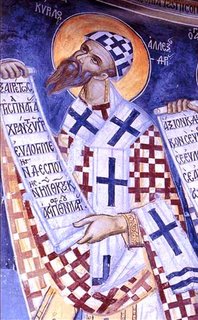 Saint Cyril (ca. AD 376-444) became Patriarch of Alexandria, Egypt in 412. Throughout his career he defended a number of orthodox doctrines, among them the teaching that Mary, the mother of Jesus, is "rightly called and truly is the Mother of God" — Theotokos, "the God-bearer" (Formula of Concord, Epitome, VIII, 12). In 431 the Council of Ephesus affirmed this teaching that the Son of Mary is also true God.
Saint Cyril (ca. AD 376-444) became Patriarch of Alexandria, Egypt in 412. Throughout his career he defended a number of orthodox doctrines, among them the teaching that Mary, the mother of Jesus, is "rightly called and truly is the Mother of God" — Theotokos, "the God-bearer" (Formula of Concord, Epitome, VIII, 12). In 431 the Council of Ephesus affirmed this teaching that the Son of Mary is also true God.The Council was responding to the Nestorian heresy, which distinguished so completely between the divine and human natures of Christ that claims were made that the divine Christ did some things while the human Jesus did others. Some of the differences are quite subtle; perhaps even Nestorius himself could not have foreseen the full ramifications of his position, including a "resurrection" of only the divine nature. Ephesus condemned the title of "Christ-bearer" (Christotokos) for the Virgin, since the Nestorians would only claim that Mary bore the Christ, but not God Himself.
Cyril receives almost as many brickbats as he does bouquets, even from orthodox Christians, because he's also known for being what one person calls "an ill-tempered, quarrelsome, hasty, and violent man." This seems especially so during his early years as Bishop of Alexandria. He closed Novatianist churches although they weren't particularly unorthodox. Their "fault" was as much one of pride as of theology — they descended from those who'd stood firm in the persecutions of earlier years and refused to associate or worship with the heirs of those who recanted the Faith under persecution. Their main theological aberration were insisting upon rebaptism of converts from "lapsed" Christianity and an attitude that was, perhaps, less than Christ-like in dealing with erring brothers.
Cyril also ran the Jews out of town. The reason given was that they were seditious and violent, although we're left with little evidence. This action likely contributed to an ongoing feud with Orestes, the imperial prefect. These disagreements seemingly spilled over into a quarrel with the prefect's friend, the neo-platonist scholar Hypatia, who was later murdered by a mob. Few have directly condemned Cyril for her death but the leaders of the mob certainly claimed the bishop as their leader. In modern times, Carl Sagan, in his book Cosmos, blamed Hypatia's death (and the destruction of the great Library of Alexandria) on dogmatic Christianity's desire to root out rational paganism. However, other scholars see the whole feud as an internal Church struggle and no one has yet established a definitive cause (or date) for the final destruction of Alexandria's library.
At any rate, and despite the considerable rancor that accompanied his early years as bishop, the mature Cyril worked diligently to reconcile the Nestorian and Orthodox parties. His efforts led many of the less virulent Nestorians back to full communion.
The writings of Cyril on the doctrines of the Trinity and the person of Christ reveal him to be one of the most able theologians of his time. Cyril's Christology influenced subsequent church councils and was a primary source for Lutheran confessional writings. He still speaks clearly to our age, especially as the old Christological heresies are trotted out under new guises.
Collect
Heavenly Father, You used Your servant Cyril to confess the mysteries of the Holy Trinity and of Your Son being one person with fully divine and human natures. Grant that we, also, might be constant in Your Word, bold in Your confession, and steadfast in Your worship, to the glory of Your holy Name; through Jesus Christ our Lord, who lives and reigns with You and the Holy Spirit, one God, now and forever.
Technorati Tags: Saint Cyril | Cyril of Alexandria | Nestorius | Nestorianism | Novatian | Novatianism | Orestes | Hypatia | Library of Alexandria | Christology | Trinity | Formula of Concord | Theotokos | Council of Ephesus
The holy prophet Jeremiah is counted as one of the four "major prophets" of the Old Testament, along with Isaiah, Ezekiel, and Daniel. His name means "Established (or Raised up) by Yahweh (the Lord)."
He was active as God's prophet to the southern kingdom of Judah ca. 627 to 582 B.C. As he fulfilled his calling, he predicted, witnessed, and lived through the Babylonian siege and eventual destruction of Jerusalem in 587 B.C.
In his preaching he often used symbols, such as an almond rod (Jeremiah 1:11-14), wine jars (13:12-14), and a potter at work (18:1-17). His entire prophetic ministry was a sermon, communicating through word and deed God's anger toward his rebellious people. He suffered repeated rejection and persecution by his countrymen. As far as can be known, he died in Egypt, having been taken there forcibly. He is remembered and honored for fearlessly calling God's people to repentance.
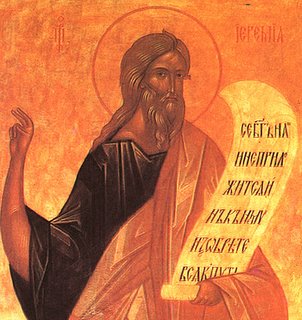 Jeremiah also is credited by many as the author of the Book of Lamentations. The book consists of five separate poems, of which the first four are acrostics consisting of verses whose first words begin with successive letters of the Hebrew alphabet. In English translations, of course, this style completely disappears.
Jeremiah also is credited by many as the author of the Book of Lamentations. The book consists of five separate poems, of which the first four are acrostics consisting of verses whose first words begin with successive letters of the Hebrew alphabet. In English translations, of course, this style completely disappears.Chapter Three is an especially well-developed acrostic. There are twenty-two letters in Hebrew and the other chapters have 22 verses. However, this chapter has sixty-six, grouping sets of three verses under each letter of the alphabet. Thus, verses one through three begin with א (aleph), verses four through six with ב (beth), seven through nine with ג (gimel), and so-on down the line. Chapter Five, while not an acrostic, still has 22 verses.
The themes of the book unfold as follows: Chapter 1 treats the fallen and desolate city of Jerusalem as a widow weeping over her loss. Chapter 2 connects her misery with the sins of the nation and her people which brought God's judgment. Chapter 3 expresses hope that the Lord's punishment will result in blessing for His people and affirms His goodness: "The steadfast love of the Lord never ceases; his mercies never come to an end; they are new every morning; great is your faithfulness. 'The Lord is my portion,' says my soul, 'therefore I will hope in him.' (vv. 22-24)" Chapter 4 is a lament on the destruction of city and temple but lays the blame upon the people's sins. The final chapter outlines the city's continuing troubles and prays that the Lord will finally restore Zion and not abandon His chosen people, although their sins are great and they certainly deserve it.
The book of Jeremiah similarly proclaims harsh judgment upon persistent sin while also reminding the Lord's people of His faithfulness. It looks to a time when the need for the Law's commands and punishments will cease and all will be made right. The clearest expression of this thought is in 31:31-34, where a "New Covenant" of grace is promised, a covenant established by the blood of the coming Messiah: "Behold, the days are coming, declares the Lord, when I will make a new covenant with the house of Israel and the house of Judah, not like the covenant that I made with their fathers on the day when I took them by the hand to bring them out of the land of Egypt, my covenant that they broke, though I was their husband, declares the Lord.
"But this is the covenant that I will make with the house of Israel after those days, declares the Lord: I will put my law within them, and I will write it on their hearts. And I will be their God, and they shall be my people. And no longer shall each one teach his neighbor and each his brother, saying, 'Know the Lord,' for they shall all know me, from the least of them to the greatest, declares the Lord. For I will forgive their iniquity, and I will remember their sin no more."
Scripture says nothing of how prophet's life ended. Chapter 43 reveals that Johanan took Jeremiah, the prophet's faithful scribe Baruch ben Neriah, and a remnant of Judean people, to live in Egypt. This directly contradicted the Word of the Lord Jeremiah had just spoken in Chapter 42, forbidding such a move and warning of dire consequences. Since Jeremiah 52:31 mentions the reign of Evil-merodach, the son of Nebuchadnezzar, many think that he may have been at least 90 years old when he died. Some ancient traditions claim that he was stoned to death in Babylon. Others say that he finally went to Babylon with Nebuchadnezzar's army.
Technorati Tags: Jeremiah | Prophet Jeremiah | Lamentations | acrostic | sin | judgment | Judah | Israel | prophecy | Messianic prophecy | Law and Gospel
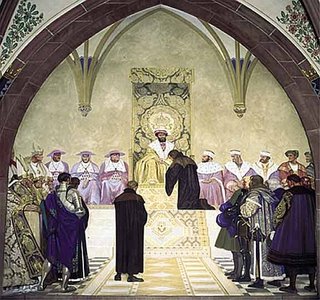 Note: Please see the Rev. Walter Snyder's Ask the Pastor for more on the history and theology of the Augsburg Confession and its presentation and the Rev. Paul McCain's Cyberbrethren for a photograph of a first edition printing of the Confession and the Apology.
Note: Please see the Rev. Walter Snyder's Ask the Pastor for more on the history and theology of the Augsburg Confession and its presentation and the Rev. Paul McCain's Cyberbrethren for a photograph of a first edition printing of the Confession and the Apology.The Augsburg Confession, the principal doctrinal statement of the theology of Martin Luther and the Lutheran reformers, was written largely by Philipp Melanchthon. At its heart it confesses the justification of sinners by grace alone, through faith alone, for the sake of Christ alone.
Signed by leaders of several German cities and regions, the confession was formally presented to the Holy Roman Emperor Charles V at Augsburg, Germany, on 25 June 1530. A few weeks later Roman Catholic authorities rejected the Confession, which Melanchthon defended in the Apology of the Augsburg Confession (1531). In 1580 the Unaltered Augsburg Confession was included in the Book of Concord.
An historical sidelight: Because of imperial protocol, Melanchthon wasn't allowed to make — or even attend — the presentation. Instead, two of the Saxon chancellors gave the oral reading and handed the written Latin and German copies to Charles V.
Lection
Psalm 46
Isaiah 55:6-11
Romans 10:5-17
John 15:1-11
Collects
O Lord God, heavenly Father, pour our Your Holy Spirit on Your faithful people, keep them steadfast in Your grace and truth, protect and comfort them in all temptation, defend them against all enemies of Your Word, and bestow on Christ's Church Militant Your saving peace; through Jesus Christ, Your Son, our Lord, who lives and reigns with You and the Holy Spirit, one God, now and forever.
Almighty God, we praise You for those You have sent to call the Church to its tasks and renew its life, including your servant Philipp Melanchthon. Raise up in our own day pastors, teachers, and theologians inspired by Your Spirit, whose voices will give strength to Your Church and proclaim Your kingdom; through Your Son, Jesus Christ our Lord.
Hymn
God's Word Is Our Great Heritage
God's Word is our great heritage
And shall be ours forever;
To spread its light from age to age
Shall be our chief endeavor.
Through life it guides our way,
In death it is our stay.
Lord, grant, while worlds endure,
We keep its teachings pure
Throughout all generations.
Notes on the Propers: The suggested readings come from the LCMS hymnal Lutheran Worship, as does the first collect. These propers are also used for the Commemoration of the Doctors of the Church, including Luther and C. F. W. Walther. The second collect is modified from James Kiefer's Hagiographies.
Technorati Tags: Augsburg Confession | UAC | Unaltered Augsburg Confession | Formula of Concord | Philipp Melanchthon | Diet of Augsburg | Lutheran | Reformation | Lutheran Reformation | Martin Luther | Book of Concord | Diet of Augsburg
For those wanting to keep up with the Big Blogroll O' Vark®™©, I offer one update and two additions.
First of all, Nonpariel has changed URLs and no longer lists an owner. If you link to the old site, please make the corrections.
As for our newbies, The Ranting Reverend, an old friend of the Aardvark, joins the "Confessional Lutheran Blogs". And though I've included it among the "Other Blogs", Agnus Day: The Lectionary Comic is drawn and written by ordained LCMS minster James Wetzstein.
Remember, all you have to do is ask and I'll send you the Big Blogroll O' Vark®™©.
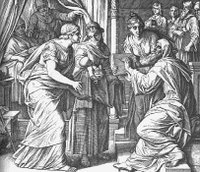 This day celebrates the birth of a son to the elderly and previously childless couple Elizabeth and Zechariah the priest. On the eighth day, his parents would name him John ("Yahweh is gracious").
This day celebrates the birth of a son to the elderly and previously childless couple Elizabeth and Zechariah the priest. On the eighth day, his parents would name him John ("Yahweh is gracious").John would grow up to be the last prophet of the Old Testament and the Forerunner of the coming Messiah, his younger cousin Jesus. Notice that today's date is six months before Christmas — the Nativity of Our Lord — since the Annunciation to Mary came "in the sixth month" of Elizabeth's pregnancy.
The Christian Church remembers Saint John the Baptizer's prophetic ministry and commemorates his death on 29 August.
Lection
Psalm 141
Malachi 3:1-4
Isaiah 40:1-5 or Acts 13:13-26
Luke 1:57-80
Collect
Almighty God, through John the Baptist, the forerunner of Christ, You once proclaimed salvation; now grant that we may know this salvation and serve You in holiness and righteousness all the days of our life; through Jesus Christ, Your Son, who lives and reigns with You and the Holy Spirit, one God, now and forever.
Technorati Tags: John the Baptist | John the Baptizer
I imagine that I'll be doing my customary commemorative post for this Sunday's observation of one of the Lutheran Church's special days. However, since Ask the Pastor has already posted a summary of the history and theology of this normative Lutheran document, I commend to you Pastor Snyder's essay on The Presentation of the Augsburg Confession.
Technorati Tags: Lutheran | Augsburg Confession | UAC | Confessio Augustana | Presentation of the Augsburg Confession | church history | Christian history | Confessional Lutheran | Lutheran Confessions | Book of Concord | Concordia
The Tarheel Lutheran, after reading posts by Rick and the Terrible Swede, wrote My Dad Is My Hero. He then found Pastor Snyder's Father's Day Reminiscences of the sainted elder Pastor Snyder and discovered that honoring his own father had "morphed into an ad hoc carnival for Dads."
Since that time, Kepler has added posts from others, a mix of reflections on the fathers they've had, the ones they've known, and the ones they are. So read My Dad Is My Hero and the linked blogs. If you know of others, please leave Kepler a comment.
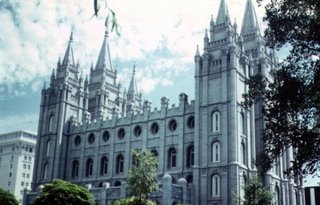 There was a time when I lived in "Mormon country," in the American Southwest. Even though I went to school with a number of LDS children, I knew little about their beliefs or history. I knew even less about how to talk with Mormons about salvation through Jesus Christ, the heavenly Father's love for them, or what the Gospel of the forgiveness of sins truly means. The phrase "Gospel ordinances" sounded a discordant note, but I never fully grasped what it meant in the lives of my Mormon school mates and friends.
There was a time when I lived in "Mormon country," in the American Southwest. Even though I went to school with a number of LDS children, I knew little about their beliefs or history. I knew even less about how to talk with Mormons about salvation through Jesus Christ, the heavenly Father's love for them, or what the Gospel of the forgiveness of sins truly means. The phrase "Gospel ordinances" sounded a discordant note, but I never fully grasped what it meant in the lives of my Mormon school mates and friends.In other words, I wish I'd known then what I know now about how to communicate Christian truth in love to Latter-day Saints. Fast forward a bunch of years and we see that "Mormon country" kept expanding. The number of temples and lesser LDS buildings and missions have greatly increased. On the Christian side, you have countless sites — created by both ex-Mormons and "Gentiles" — who don't want to see their Mormon friends, neighbors, and family members spend an eternity in the outer darkness. The trouble is, some of these sites are fairly good while others either beat up on the Saints without mercy or else confound faith and works so badly that their ultimate message is hardly different from that of Mormonism.
Now, if you're familiar with the terminology of the Church of Jesus Christ of Latter-day Saints, you've noticed that I'm somewhat guilty of "keyword stuffing." If you didn't notice, you're either not LDS or you're a Mormon in name only. The LDS definitions of Jesus Christ, heavenly father, salvation, forgiveness, and Gospel all vary significantly from those used by orthodox Christianity. This means that when Mormons and Christians talk, we often find ourselves agreeing with each other because each of us means something quite different.
I used some of these terms to show Christians that we have our work cut out for us. I also did so to invite Mormon web surfers to read this post and, with God's guidance, visit some sites where people who both care about Mormons and understand the differences between LDS doctrine and true Christian theology are ready to talk with you — not at you or about you.
If you're a member of the LDS, someone considering becoming a Mormon, or a Christian who wants to talk about your faith with Mormons, I have a few suggestions. We need to understand each other in conversation. We need to agree what God really said. We need to focus on what people in our churches actually think and not resort to mindless stereotyping.
Some of the best recent material for defining terms and learning to effectively confess the Christian Faith to Mormons comes from those who live and work among the LDS. Of these, I value the efforts of Pastor Mark Cares of the Wisconsin Evangelical Lutheran Synod and those who work with him above anything else I've seen.
The newest large-scale effort to reach out to members of the LDS is at The City of Zion. This cyber community is steeped in language and imagery familiar to Mormons. It consists of a number of "buildings," each of which focuses on specific points of Mormon doctrine and practice. The city will be under construction for some time. As the front page notes, "It takes two to three months of effort to develop the content required to open one building." So far, Zion Gate, the Visitor's Center, the Post Office, the Temple, the Family History Center, and the Gem Shop are open. If you are either a Mormon or a Gentile visitor and find anything you think should be working but isn't, or if you have more questions, they're prompt at answering you from the feedback link at the Post Office.
The City of Zion has a couple of established companion sites. Truth in Love to Mormons is largely based upon Pastor Cares' excellent book and companion video, Speaking the Truth in Love to Mormons. It features a wealth of downloadable material that can be used in Bible classes and for preparation to actually witness Biblical Christianity to Mormons. Truth in Love Ministry functions as sort of a "parent" site, where various aspects of this special work among the LDS, including contact information, the rationale for the ministry, and means of support, are addressed.
Technorati Tags: Mormon | Lutheran | Christian | LDS | Latter-day Saints | Church of Jesus Christ of Latter-day Saints | The City of Zion | evangelism | witnessing | Christianity
A Beggar at the Table, the blog of heretic-hunting Pastor Alex Klages, is hosting Lutheran Carnival 26.
Ask the Pastor wrestles with a woman's questions involving Changing Towns, Changing Churches. A cradle Lutheran from the North moves into the Bible Belt South as her husband's job changes. She worries that she won't "fit into town" unless she joins the local Baptist church. A key question (answered with a fair amount of tact and restraint): "Is this a spiritually shallow approach to religion?"
The bottom line: "If you believe like a Baptist, then become a Baptist. If you believe like a Lutheran, then remain a Lutheran."
Michael "Stingray" McCullough has a detailed analysis of the benefits stemming from the timely demise of Abu Musab al-Zarqawi. He also examines the spin coming from certain members of the "loyal opposition."
There's some interesting reading at Get Religion, where Terry Mattingly wonders, Where did all the men go (again)?
Please make note of the following additions, changes, and deletions. The first set are for the Confessional Lutheran section, the second are listed among my "Other Blogs."
- Confessional Lutherans
- Another Blog by Etz New
- The Crowned Ones New URL
- Cruising Down the Coast of the High Barbaree New Name; was A Finger for Each Nostril
- Eating Words New Name and URL; was Living Among Mysteries
- Free & Bound Deleted; 404
- Little Mouse on the Prairie New
- A Lutheran Teen Blog Deleted; 404 (vultures have it)
- Pistol Packin' Presbytera New
- Preach. Teach. Confess. Deleted; 404 (vultures have it)
- ProtoEvangel New
- Christina Schellenbach New Name; was Christina Kirk
- Theo[logical] Universe New
- Other Blogs
- Another Faith Blog Deleted; not posting
- JollyBlogger New
- Personal Diatribes Deleted; not posting
Remember that you're welcome to email me and ask for a copy of the Big Blogroll O' Vark®™©. Please let me know if you want the full list or just the Confessional Lutherans.
Elisha, son of Shaphat of the tribe of Issachar, was the prophet of God to the northern kingdom of Israel ca. 849-786 B.C. Refusing to leave his mentor's side during Elijah's final days on earth, once he saw the elder prophet taken up into heaven, Elisha took up Elijah's mantle and assumed the prophetic office (2 Kings 2:1-14).
Like Elijah, Elisha played an active role in political affairs. He also performed many miracles, such as curing the Syrian army commander Naaman of his leprosy (2 Kings 5:1-27) and restoring life to the son of a Shunammite woman (4:8-37). A vocal opponent of Baal worship, Elisha lived up to his name, which means "my God is salvation."
Technorati Tags: Elisha | Elijah | Naaman | prophet | Shunammite woman | liturgical calendar
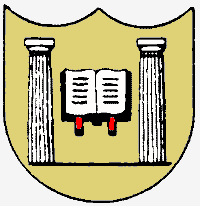 The Christian Church's First Ecumenical Council was convened in Nicaea (modern Isnuk, Turkey) in the early summer of AD 325 by the Roman Emperor Constantine. The emperor presided at the opening of the council. The major intended topic was the ongoing Arian controversy.
The Christian Church's First Ecumenical Council was convened in Nicaea (modern Isnuk, Turkey) in the early summer of AD 325 by the Roman Emperor Constantine. The emperor presided at the opening of the council. The major intended topic was the ongoing Arian controversy.The council ruled against the Arians, who taught that Jesus was not the eternal Son of God but was created by the Father and was called Son of God because of his righteousness. The chief opponents of the Arians were Alexander, bishop of Alexandria, and his deacon, Athanasius. The council confessed the eternal divinity of Jesus and adopted the earliest version of the Nicene Creed, which in its entirety was adopted at the Council of Constantinople in 381.
Other topics included celebration of the Resurrection and how the date for Easter would correspond with Passover, the Miletian schism, validity of baptism by heretics, and the restoration lapsed Christians who renounced the Faith under persecution. The Council also established a number of new canons (Church laws). Enumeration varies, but twenty is the number suggested by the editors of the Early Church Fathers:
1. prohibition of self-castration, as done by Origen;
2. establishment of a minimum term for catechumens;
3. prohibition of the presence in the house of a cleric of a younger woman who might bring him under suspicion;
4. ordination of a bishop in the presence of at least three provincial bishops and confirmation by the metropolitan;
5. provision for two provincial synods to be held annually;
6. exceptional authority acknowledged for the bishops of Alexandria and Rome, for their respective regions;
7. recognition of the honorary rights of the see of Jerusalem;
8. provision for agreement with the Novatianists;
9-14. provision for mild procedure against the lapsed during the persecution under Licinius;
15-16. prohibition of the removal of priests;
17. prohibition of usury among the clergy;
18. precedence of bishops and presbyters before deacons in receiving Holy Communion, the Eucharist;
19. declaration of the invalidity of baptism by Paulian heretics;
20. prohibition of kneeling during the liturgy, on Sundays and in the fifty days of Eastertide. (Summary from Wikipedia.)
Their version of what we now call the Nicene Creed was almost identical to what is now used in the Church until the third section, where the original ends, "We believe in the Holy Spirit." It fell to the Second Ecumenical Council (First Council of Constantinople) to add what is now used. Therefore, the confession used in the churches may properly be called the Niceno-Constantinopolitan Creed. The so-called filioque (where "and the Son" was inserted after the words about the Spirit proceeding from the Father) was only later added by the Roman Catholic Church and never accepted in the East.
The Council also saw the first major collaboration between Church and state since Christianity began and signaled a rise in imperial influence in affairs of the Church. Constantine called it, presided over the initial session, and, in many respects, set its agenda. While his personal religious beliefs may have been part of his reason, most scholars agree that his main fear was that a divided Christianity would result in a divided Empire. The historical irony is that the Roman Empire fractured before any major schisms in Christendom.
Nicene Creed
And in one Lord Jesus Christ, the only-begotten Son of God, begotten of His Father before all worlds, God of God, Light of Light, very God of very God, begotten, not made, being of one substance with the Father, by whom all things were made; who for us men and for our salvation came down from heaven and was incarnate by the Holy Spirit of the virgin Mary and was made man; and was crucified also for us under Pontius Pilate. He suffered, and was buried. And the third day He rose again according to the Scriptures and ascended into heaven and sits at the right hand of the Father. And He will come again with glory to judge both the living and the dead, whose kingdom will have no end.
And I believe in the Holy Spirit, the Lord and Giver of Life, who proceeds from the Father and the Son, who with the Father and the Son together is worshiped and glorified, who spoke by the prophets. And I believe in one holy Christian [catholic] and apostolic Church, I acknowledge one Baptism for the remission of sins, and I look for the resurrection of the dead and the life ✠ of the world to come. Amen.
Technorati Tags: Council of Nicaea | First Ecumenical Council | Nicene Creed | Niceno-Constantinopolitan Creed | Athanasius | Nicaea
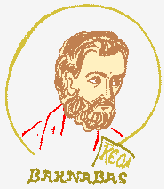 "Joseph, who was also called by the apostles Barnabas (which means son of encouragement), a Levite, a native of Cyprus, sold a field that belonged to him and brought the money and laid it at the apostles' feet" (Acts 4:36-37). Here Scripture makes first mention of Saint Barnabas.
"Joseph, who was also called by the apostles Barnabas (which means son of encouragement), a Levite, a native of Cyprus, sold a field that belonged to him and brought the money and laid it at the apostles' feet" (Acts 4:36-37). Here Scripture makes first mention of Saint Barnabas.This name given by the Apostles matches what we know of his actions. When Saul of Tarsus (or Paul) came to Jerusalem after his conversion, most of the congregation wanted nothing to do with him. They knew him only as a persecutor and an enemy of Christ's Church. Barnabas, however, willingly gave him a second chance. He sought him out, spoke with him, and brought him to meet the other Christians, vouching for him.
Later, Paul and Barnabas went on a missionary journey together, taking Barnabas's cousin Mark along. Part way, Mark turned back and went home. When Paul and Barnabas were about to set out on another such journey, Barnabas proposed to take Mark along, and Paul was against it, saying that Mark had shown himself undependable. Barnabas wanted to give Mark a second chance, and so he and Mark went off on one journey, while Paul took Silas and went on another. Apparently Mark responded well to the trust given him by the "son of encouragement," since we find that Paul later speaks of him as a valuable assistant (2 Timothy 4:11; see also Colossians 4:10 and Philemon 24).
Lection
Psalm 135:1-7
Isaiah 42:5-12
Acts 11:19-30; 13:1-3
Matthew 10:5-16
Collect
O Almighty God, by Your Son, our Savior, You have always given to Your Church on earth faithful shepherds to guide and feed Your flock. Therefore we pray, make all pastors diligent to preach Your holy Word and minister Your means of grace, and grant Your people wisdom to follow in the way that leads to life eternal; through our Lord Jesus Christ, who lives and reigns with You and the Holy Spirit, one God, now and forever.
Technorati Tags: Saint Barnabas | Barnabas | Joseph | Apostle Barnabas | Saint Paul | Saint Mark
The Feast of the Holy Trinity, or Trinity Sunday, is a movable festival on the Church calendar in Western Christendom. Its date of celebration depends, as do Lent, Ascension Day, and Pentecost, upon the date of Easter.
Often, the Church Year is divided into two approximate halves. The "festival half," sometimes (rather inappropriately, in my opinion) termed "the Lord's half year," runs from the First Sunday in Advent through the week following Pentecost. This period encompasses all of the major Christological observances. Trinity Sunday is sometimes considered the close of the festival half but usually understood to be the beginning of the non-festival half, sometimes called "the Church's half year." Its proper liturgical color is white, but except for certain special observances, green will be used for paraments and vestments until the church year closes.
This day celebrates the mystery of the Holy Trinity, Father, Son, and Holy Spirit — One God yet Three Persons — a fact revealed in Scripture but apprehended only by faith, since its comprehension defies human logic. Regardless of the lectionary cycle used, the appointed Scriptures for the day reflect both God's undivided unity of self and His Triune nature. While not often used by most of the Christian Church during the rest of the year, much of the Western Church uses the Athanasian Creed as its confession of faith on Trinity Sunday.
Lection — One-year Series
 Psalm 8 or 148
Psalm 8 or 148Ezekiel 18:30-32
Romans 11:33-36
John 3:1-15
Lection — Three-year Series, Year B
Psalm 96
Deuteronomy 6:4-9
Romans 8:14-17
John 3:1-17
Collect
Almighty and everlasting God, You have given us grace to acknowledge the glory of the eternal Trinity by the confession of a true faith and to worship the Unity in the power of the Divine Majesty. Keep us steadfast in this faith and defend us from all adversities; for You, O Father, Son, and Holy Spirit, live and reign, one God, now and forever.
Hymns
Holy, Holy, Holy
Holy, holy, holy! Lord God Almighty!
Early in the morning our song shall rise to Thee;
Holy, holy, holy, merciful and mighty!
God in three Persons, blessèd Trinity!
Holy, holy, holy! All the saints adore Thee,
Casting down their golden crowns around the glassy sea;
Cherubim and seraphim falling down before Thee,
Who was, and is, and evermore shall be.
Holy, holy, holy! though the darkness hide Thee,
Though the eye of sinful man Thy glory may not see;
Only Thou art holy; there is none beside Thee,
Perfect in power, in love, and purity.
Holy, holy, holy! Lord God Almighty!
All Thy works shall praise Thy Name, in earth, and sky, and sea;
Holy, holy, holy; merciful and mighty!
God in three Persons, blessèd Trinity!
Holy God, We Praise Your Name
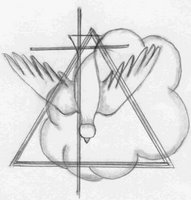 Holy God, we praise Your Name;
Holy God, we praise Your Name;Lord of all, we bow before You.
All on earth Your scepter claim,
All in heaven above adore You.
Infinite Your vast domain,
Everlasting is Your reign.
Hark! The glad celestial hymn
Angel choirs above are raising;
Cherubim and seraphim,
In unceasing chorus praising,
Fill the heavens with sweet accord:
"Holy, holy, holy Lord!"
Lo, the apostolic train
Join Your sacred Name to hallow;
Prophets swell the glad refrain,
And the white robed martyrs follow;
And from morn to set of sun
Through the Church the song goes on.
You are King of Glory, Christ;
Son of God, yet born of Mary.
For us sinners sacrificed,
As to death a Tributary,
First to break the bars of death,
You have opened heaven to faith.
Holy Father, holy Son,
Holy Spirit, Three we name You,
Though in essence only One;
Undivided God we claim You
And, adoring, bend the knee
While we own the mystery.
Technorati Tags: Holy Trinity | Trinity Sunday | Trinity | Triune God | Church Year | liturgical calendar
 First, keep in mind the usual caveats about drinking to excess, addiction, and the like. Second, realize that all tequilas are not created equal. Cheaper tequila may use as little as 51% blue agave mixed with corn or cane sugar in fermentation (mixto); premium tequila will be pure agave. Gold tequila (tequila oro) is not aged for a significant period; caramel coloring is added to "younger" silver (plata) or white (blanca) tequila.
First, keep in mind the usual caveats about drinking to excess, addiction, and the like. Second, realize that all tequilas are not created equal. Cheaper tequila may use as little as 51% blue agave mixed with corn or cane sugar in fermentation (mixto); premium tequila will be pure agave. Gold tequila (tequila oro) is not aged for a significant period; caramel coloring is added to "younger" silver (plata) or white (blanca) tequila.The better tequilas achieve their darker color through natural processes. A reposado (rested) tequila is aged, usually in oak, for about a year. An añejo (aged or vintage) tequila sits in its cask for 1 to 3 years — and maybe longer. The extremes of the spectrum are about as noticable as in whisky.
While a decent margarita can be made from any decent tequila, moving up in tequila quality will, of course, improve margarita quality. Personally, I prefer to begin no lower than, say, Cuervo Tradicional, a reposado. It's a decent meeting of price versus quality. Let your own taste and budget be your guides. (The better tequilas are also much better in shots straight from the freezer.)
I firmly believe that a frozen margarita adds too much water (from all the ice) — a good margarita, where one can enjoy its complementing flavors fully, should be on the rocks. Chill the drink before pouring, and you'll be able to get by with minimal ice and maximal taste.
The Aardvark's Mexitalian Margarita
 You'll need a pitcher — or a container suitable for shaking — that holds at least 58 to 64 ounces.
You'll need a pitcher — or a container suitable for shaking — that holds at least 58 to 64 ounces.Start with one 12 oz. can frozen limeade (I prefer Minute Maid).
Introduce the Mexican: Pour in 1 1/2 can (18 oz.) — more or less — of your chosen tequila.
Here comes the Italian: Add 6-9 oz. (1/2 to 3/4 can) Tuaca Italian Liqueur.
Finally, add enough water to make 58-64 ounces of the completed product. (If your tap water is highly mineralized or chlorinated, you might want to choose bottled water.) Chill, shake or stir, and serve over ice in a cool (salt-rimmed optional) glass.
Garnish as you desire; I prefer lime wedges.
Some folks like to strain their margarita mix into the glasses. Do so if you must. I think the little bit of lime pulp adds taste and character to the drink.
Please don't drive yourself home from Margaritaville without a good night's rest.
Tags: margarita | tequila | Tuaca | reposado | añejo | Mexican | Italian | lime | salt | Margaritaville
Cross-posted at Purpose Driven Drinking.
"[W]hen theological controversies arise, many people wisely turn to an anonymous crank with a web log. Or, as I prefer, to a Big-Time Internet Theologian."
 No, I'm not quoting myself. However, this preface by the writer of The Medicine Box should prepare you to read The Internet Theologian Explains The Da Vinci Code.
No, I'm not quoting myself. However, this preface by the writer of The Medicine Box should prepare you to read The Internet Theologian Explains The Da Vinci Code.Unlike your humble, self-effacing Aardvark, "holyoffice" is no Lutheran pastor protecting his identity through a carefully constructed internet alias. Nothing so noble — he's a "card-carrying Catholic" and an ink-stained wretch with an interest in the divine, someone who covers "religion for a newspaper" protecting his identity through a carefully constructed internet alias.
Be careful: If you're one of those LOL, spew - coffee - on - the - monitor readers, take the usual precautions before reading The Internet Theologian Explains The Da Vinci Code.
Technorati Tags: Jesus | Da Vinci Code | Dan Brown | humor | The Medicine Box
Most of this group come from within confessional Lutheranism. The JollyBlogger, a Reformed blogging mainstay, will probably be familiar to many readers. As always, potential Aardie honorees may be suggested by anyone but the final decision (and blame) rests upon yours truly.
But enough talking about the Golden Aardvarks, let's get on to giving 'em away
‡ Leading off is the always readable Beggars All. Tim, Caspar, and Jon form as fine a trio as you'll find. Jon's run-on title caught my eye and I'm glad I stayed to read it all: "Snoopy, Come Home" and the State of Lutheranism, A Quick Lesson on Foreshadowing and Leitmotifs and My Farewell — for now. While he may not be posting quite so frequently for a while, he claimed in a later post that he has a good excuse: "Our new baby will be born tomorrow. Keep us in your prayers." We shall, Jon.
‡ Sex Is Good, says the JollyBlogger. No wonder he's so jolly. It's an interesting look, triggered at least in part by The Da Vinci Code, at true Christianity's appreciation of sex. In the process, he takes many of the early fathers to task for continually equating original sin and sexuality.
‡ Too much alliteration? Probably so, but Tutal's Esotropic Tome of Tenatious Toothpics still came up with an intriguing response to too much "thinking outside the box" among pastors as Tutal asked his fellow seminary students, What's Wrong with the Box?
‡ Please Don't Stand There — Do Something. How many times have we heard this appeal. This time, Favorite Apron decries the militarization of American women. While her concerns include dealing with individuals, she also wants us to be proactive on behalf of all young women, in case the draft is reinstituted. Since so many protections for women have been eroded in the name of equality, there's a high probability that the next lottery will be sex-blind.
‡ At Die Heilige Kirche, Kevin Spaeth urges Lutherans to be fully aware of not only what's happened since 1500, but of the entire sweep of Christian history. In History on Our Side, he says that the the fathers will, time after time, line up with confessional Lutheran theology.
‡ Deaconess Emily Carder's Issues on Oprah at Quicunque Vult focues on part of a recent discussion on KFUO's Issues, Etc. program. There, she dealt with the works-oriented spirituality that's promoted by Oprah Winfrey.
‡ Eggs, Bread, Coffee, and Liturgical Conversation — doesn't it sound like Father Hollywood knows how to start the day? Here, he winsomly leads the reader into a comparison of liturgy-lite with elevating "the level of dignity and glory in our worship so as to please God and teach our people the miracle of Christ among us."
‡ In his classicly succinct manner, Dan at Necessary Roughness touches upon most of the major issues and concerns with the newly announced HPV vaccine in Paying for Consequences, Known and Unknown.
‡ Ask the Pastor cited him today in a post on Communion Practices and I had already decided that his straightforward essay on not monkeying with the elements of the Sacrament would receive an Aardie the next time I handed them out. So if you haven't already seen Why I Let My Yes Be Yes: a Soliloquy on the Sacrament for Memorial Day, I strongly encourage you to read this piece by Father Eckardt at Gottesblog.
‡ Sometimes, in my almost completely monocultural rural area, I can be lulled into forgetting some of the more diverse places I've lived. Yet even when surrounded by blacks or Hispanics, I never had any clearer picture of life among "the others" than Chris Pluger granted with Not Wrong, Just Different. Here's one more reason why I was delighted to find Café Diem and add it to the Big Blogroll O' Vark®™©.
‡ Maria of Musical Ramblings discovered A Dictionary to Understanding Pop Evangelicals on a message board "and couldn't resist passing it along." If you think that you're a Lutheran and some of these don't give you a few chuckles — and a case of heartburn — think again. Sadly, however, many of these buzzwords have made significant inroads in allegedly Lutheran congregations among allegedly Lutheran pastors and laity.
And so another gold-toned shipment leaves the burrow.
"What's Quicunque Vult?" you ask.
"Whoever desires" &mdash to be saved, that is.
These Latin words begin the Church's confession of faith commonly called the Athanasian Creed. This statement of belief, named in honor of the theologian who defended the Faith against the Arian heresy and who helped to construct the Nicene Creed, provides a detailed exposition of who God is (and what He isn't). It grew out of monastic prayers, specifically the Office of Prime.
Some churches still use the Athanasian Creed at least intermittently throughout the Church Year. Others, including most Lutherans, generally only join in reciting this particular confession on Trinity Sunday (the Sunday following Pentecost). For those interested in a responsive reading, whether for themselves or for corporate worship, Ask the Pastor posted this link to a copy-ready PDF file, formatted for responsive reading and including a brief introduction.
Also, the current Lutheran Carnival is up and running at Journalistic Jargon. Thanks to Mrs. T. Swede for compiling Lutheran Carnival XXV: Whitsunday, including the material on Dr. C. F. W. Walther.
Sure we can — in IRC.
Yep, there's a confessional Lutheran chat channel on Internet Relay Chat called #tabletalk. Monergon, the "Mon" of the blog Theomony, recently posted some of the basics in Lutheran Chat Shameless Self-Promotion.
It's really not all that difficult, just follow some of Mon's links and suggestions. Along with her suggested software, if you like to IM and IRC at the same time, you might consider using Trillian.
Drop by #tabletalk. You might get to chat with Aardvarks, geologists, and all other manner of Lutheran critters.
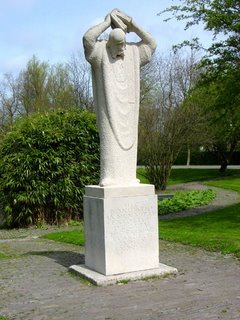 The man who later became known as Saint Boniface was born around AD 670-680 at Crediton, Devonshire, England and baptized Winfrid or Wynfrith. Although he was educated, he became a monk — at that time a calling often avoided by people of learning or means. While still in England, he was ordained as a presbyter and was inspired by the example of others to become a missionary.
The man who later became known as Saint Boniface was born around AD 670-680 at Crediton, Devonshire, England and baptized Winfrid or Wynfrith. Although he was educated, he became a monk — at that time a calling often avoided by people of learning or means. While still in England, he was ordained as a presbyter and was inspired by the example of others to become a missionary.Upon receiving a papal commission in 719 to work in Germany, Winfrid devoted himself to starting, organizing, and reforming churches and monasteries in Hesse, Thuringia, and Bavaria. After becoming an archbishop, Boniface was assigned to the See of Mainz in 743. Ten years later he resigned his position to engage in mission work in the Netherlands.
His time of activity overlapped the period in which Pippin the Younger and Charlemagne reigned and his work of converting the Saxons to Christianity was seen as a boon for expansion of Frankish rule. Yet Boniface never operated as a pawn of the kingdom of the left hand. Instead, he balanced alliances among the Carolingians, Bavarian rulers, and the papacy and often consecrated bishops who were already his followers in order to keep others from meddling in ecclesiastical affairs.
History isn't clear as to exactly when people began calling Winfrid "Boniface," Latin for "good deeds." However, his entire life gives ample testimony to events which would lead to this appellation.
Among his most famous exploits was the felling of Thor's Oak, an ancient tree believed sacred to the Nordic and Germanic god of thunder. Accounts from the period relate that when Thor (or Donar/Donner) didn't strike him dead with a lightning bolt, the locals agreed that the Christian God was supreme and agreed to be baptized. In a practical yet also symbolic gesture, Boniface used the wood of the fallen tree in the construction of a chapel in Fritzlar.
On June 5, 754, while awaiting a group of converts for confirmation, Boniface and his companions were murdered by a band of pagans in Friesland. The above picture is a commemorative statue in Dokkum, The Netherlands — a town near where he was martyred. Erected in 2004, it commemorated the 1250th anniversary of his death. Boniface is known as the apostle and missionary to the Germans and, according to historian Christopher Dawson, no other Englishman had any greater influence upon Europe's history.
Lection
Psalm 115:1-8 or 31:1-5
Acts 20:17-28
Luke 24:44-53
Collect
Almighty God, who called Your faithful servant Boniface to be a witness and martyr in the lands of Germany and Friesland, and by his labor and suffering raised up a people for Your own possession, pour forth Your Holy Spirit upon your Church in every land, that by the service and sacrifice of many Your holy Name may be glorified and Your kingdom enlarged; through Jesus Christ our Lord, who lives and reigns with You and the Holy Spirit, one God, now and forever.
Technorati Tags: Saint Boniface | Boniface of Mainz | Winfrid | Germany | Friesland | Thor's Oak
Pentecost, an Israelite festival, was the time chosen by the Lord for the special outpouring of the Holy Spirit upon the disciples as they waited in Jerusalem. With wind and fire, the Holy Spirit manifested Himself upon the apostles, who rushed out to begin proclaiming the Gospel of Christ crucified for our sins and raised for our justification. The account is in Acts 2:1-41.
Lection: 3-Year Cycle, Series B
Psalm 143
Ezekiel 37:1-14
Acts 2:22-36
John 7:37-39a
Collect
O God, on this day You once taught the hearts of Your faithful people by sending them the light of Your Holy Spirit. Grant us in our day by the same Spirit to have a right understanding in all things and evermore to rejoice in His holy consolation; through Jesus Christ, Your Son, our Lord, who lives and reigns with You and the Holy Spirit, one God, now and forever.
As I noted in an earlier post, the Time review of The Da Vinci Code mentioned that Brigham Young believed that Jesus was married. This, I figured, was congruent with Mormon doctrine but I chose to focus on the comments concerning Martin Luther.
Now Ask the Pastor has just posted The Da Vinci Code: Mormons and the Marriage of Jesus. In it, Pastor Snyder uses primary sources to show how not only Young, but much of Mormonism, has held the belief that Christ was married — often claiming that He (and His Father) have multiple wives in the heavenly realms.
Technorati Tags: Jesus | Mary Magdalene | married | Mormon | Brigham Young | Da Vinci Code | LDS

